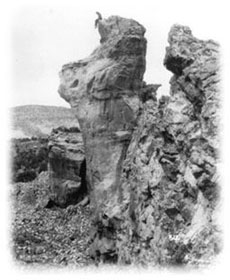Trip 2: The A.D. 1800s |
Castle Rock Pueblo Explored |
|

The Mystery for Trip 2: Since the ancestral Puebloans left, many other people have explored McElmo Canyon and visited Castle Rock Pueblo. Some people have made the canyon their home. Search through historic records and photographs to solve this mystery: What are the oldest buildings in McElmo Canyon? |
||

We believe that Castle Rock Pueblo became an important landmark for people traveling through McElmo Canyon long after the ancestral Puebloan people moved away from their village. This canyon is a natural corridor connecting the mountains of southwestern Colorado with the canyon country of southeastern Utah. We know that the Puebloans, the Ute Mountain Utes, the Navajo, the Spanish, and the Anglo peoples all used McElmo Canyon. |
||
 Ute Mountain Ute History Ute Mountain Ute History
Western Colorado, eastern Utah, and northern New Mexico have been home to bands of Ute people for hundreds of years. Today the Ute Mountain Ute (Weeminuche band) live in southwestern Colorado and southeastern Utah. A long time ago, but after the ancestral Puebloans left the area, Ute people lived in McElmo Canyon during the fall and winter. In the spring and summer, they spent much of their time in the mountains. The Ute were hunters and gatherers, which means they didn't stay in one place for very long. Their houses were temporary to fit their lifestyle. They followed migrating animals that they hunted, and they collected seeds, berries, and other plants. They traded with other tribes for food and other items, such as jewelry. The Ute acquired horses from the Spanish in the 1640s. Horses made traveling and hunting easier for everyone, and people could travel together in larger groups. House styles changed to include teepees, tents, and shade houses. Hogans similar to Navajo hogans were used too. |
||

In the 1800s, gold and silver were discovered in Colorado's mountains, and many Anglos began moving to the area to mine these precious metals. The Ute people moved from their traditional homelands and lost access to the lands that they had used for hundreds of years for seasonal living and hunting. They went to live on reservations in Utah and southwestern Colorado. After the Anglos settled in southwestern Colorado, Ute people worked for the farmers, planting in the spring and harvesting crops and picking apples and peaches in the fall. Today only a small part of McElmo Canyon is owned by the Ute Mountain Ute Tribe, and few tribal members still live in the canyon. |
||

The Ute Mountain Ute Tribe established a permanent home on the east slope of Sleeping Ute Mountain. The Utes continue to practice traditional beliefs, but they have modern homes and lifestyles. Teepees and shade houses are still used seasonally. The Ute people know about the ancestral Puebloan sites on their land. Out of respect for a different culture, they have left most of these sites untouched. |
||
Trip 1  |
Trip 2  |
Trip 3  |
 DONATE TODAY
DONATE TODAY
